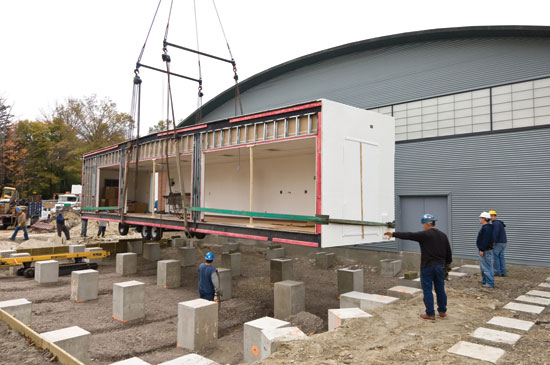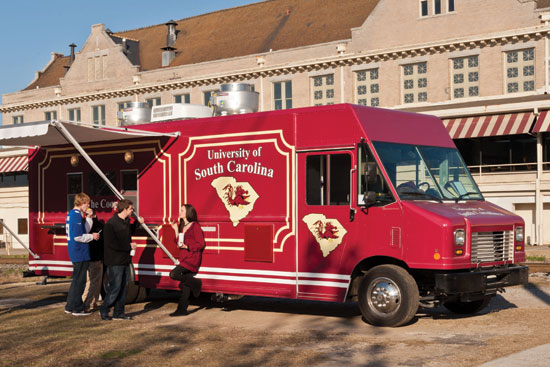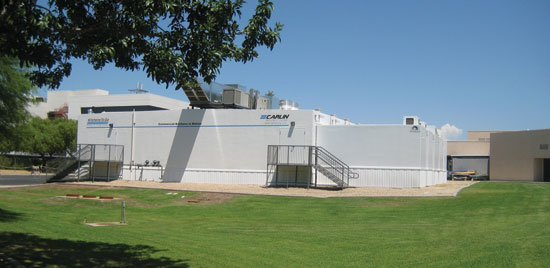Interim Executive Dining Facility Bridges Construction Gap at Business School
Faster construction speed and lower costs. Fabric structures are engineered to enable lower project costs and reduced operating expenses, and are often chosen for their speed of deployment. Completion of an entire architectural membrane structure takes a fraction of the time of conventional construction alternatives. Custom structures can be erected at a rate of up to 1,000 square feet per day for insulated structures, and 2,000 square feet per day for non-insulated structures.
There are several reasons for this. The permitting process, for example, can be substantially reduced as manufacturers typically will supply a comprehensive permitting package, complete with drawings and supporting calculations, all stamped by a licensed engineer certified in the region where the project is located. In addition, the lightweight aluminum substructure reduces the size of footings or foundations when compared to conventional steel buildings, and provided appropriate soil conditions exist, less permanent applications require no subsurface foundations for structures up to 180 feet wide.
Depending on the complexity of the fabric structure, design time can average three to four weeks versus two to three months for a pre-engineered building and six to eight months for conventional structures, with construction completed in six months, in some cases half the time of the other two types of buildings. All components come to the site pre-fabricated. Arches can be raised and the exterior membrane installed within a few days of commencing work, giving contractors a roof overhead very early in the erection cycle, and allowing construction in extreme weather and climate conditions.

Photo courtesy of Kitchens To Go/Sprung Structures
Glazing walls help maximize interior daylight.
Maintenance is minimal as the aluminum substructure is maintenance free, and the architectural membrane is easily cleanable. Conventional buildings require regular maintenance and with a pre-engineered metal building, a standing seam metal roof is prone to large thermal movements that create leaking and require continuous maintenance, especially at penetrations.
Durability. Fabric structures have a long life span and can withstand extreme weather. In particular, the aluminum substructure has an indefinite life expectancy, and the architectural membranes average a 20-year life span. Future replacement membranes are inexpensive.
Energy efficiency. Constant research, testing, and development have led to fabric structures that provide better climate control. As mentioned previously, thicker insulation used leads to maximum performance and comfort as well as reduced climate control costs and sound absorption. Insulation performs better because a highly tensioned exterior architectural membrane structure provides a significantly better airtight building envelope than conventional building envelopes. High performance architectural membrane structures are designed to keep warm air in, and cold air out and, combined with an effective climate-controlled insulation system, can achieve low air permeability—nearly 0—that can yield up to 45 percent savings on energy bills compared to pre-engineered metal buildings and other conventional structures. Poor airtightness is a drawback of pre-engineered metal buildings, though moderate air tightness can be achieved in conventional construction. A PVC-coated fabric on both the interior and exterior of the structure, in fact, can provide five times the airtightness of a conventional building, increasing the efficiency of the insulation and lowering HVAC and other operating costs.
Interim Kitchen Facilities
Interim kitchens are a new opportunity available to architects, foodservice consultants, general contractors, and the foodservice marketplace as an alternate solution to be able to provide continuity of foodservice operation during a time of planned or unplanned renovation of an existing foodservice facility or in the event of a natural or manmade disaster. All market segments of the foodservice industry utilize interim kitchen facilities, including education, healthcare, corrections, military, disaster relief and recovery, natural resource work camps – oil and mining, business and industry, hospitality and catering, quick-serve (fast food), and senior living.

Photo courtesy of Kitchens To Go
Bolt-on kitchens provide the ability to create extra space or transform a facility without the inconvenience of rehab and renovation.
Types of Interim Kitchens
Various types of interim kitchen facilities can meet foodservice operators needs and present benefits over alternative solutions.
Bolt-On kitchens. New food-service production facilities can be fabricated and either temporarily or permanently connected to an existing building. Reasons to consider a bolt-on kitchen include a facility expansion, addition or replacement; reallocation of existing interior space for alternate applications such as administrative and dining; expanded production capacity; additional prep space, cold and dry storage.
Providing the ability to create extra space or transform a facility without the inconvenience of rehab and renovation, this option is geared toward commercial food service operations that do not have the luxury of waiting up to eight months for permit approvals, design plans, and the traditional build out. Rather than disrupt daily food service operations, owners can take delivery of new code-compliant kitchen generally within a two- to three-month period in a process that trumps conventional construction in terms of a more efficient building profile that generates less waste. By affixing a pre-constructed kitchen to an existing building, operators can save both time and money over conventional construction costs. Because the fabrication takes place concurrently with the renovation's site development work, the projects run on parallel timelines—a scenario that reduces downtime substantially compared with traditional construction. The solution also provides the opportunity for operators to recapture existing space in their facilities for other applications, such as expanded dining or administrative space by moving the existing kitchen outside the building's footprint.
Architecturally, the modular unit's design can match the décor of the existing building to which it is adjoined. The bolt-on kitchen is joined by a common sidewall and delivered with an interior and exterior that are custom finished to reflect the operator's brand image. The facility is sufficiently versatile to serve as a permanent structure that is built to current building codes; alternatively it can be relocated wherever it is needed. LEED-certified bolt-ons are available.
Mobile kitchens. Candidates for mobile kitchens include quick-serve and off-premise foodservice operators for a spectrum of education, healthcare, corrections facilities as well as for first responders that assist victims of natural and man-made disasters.

Photo courtesy of Kitchens To Go
Candidates for mobile kitchens include quick-serve and off-premise foodservice operators.
Modular kitchens. As distinguished from traditional mobile kitchens, modular kitchens involve both single unit modules (SUM) and modular kitchen complexes. Modular kitchens are often used when food service operation requires a new permanent facility, or drive-thru concept. These kitchens are a purpose-built, clear span space that enables an efficient commercial kitchen environment. Both health and building code compliant, these facilities include certified exhaust hoods with engineered make-up air, fire protection systems, and HVAC.

Photo courtesy of Kitchens To Go
As distinguished from traditional mobile kitchens, modular kitchens involve both single unit modules (SUM) and modular kitchen complexes.
PAC kitchens. Plug-and-cook (PAC) kitchens are single containerized units that provide substantial production cooking capacity in an easily deployable unit that can be placed and operational in 45 minutes. PAC kitchens are ideal for military applications, disaster relief or special events. With optional hydraulic leveling legs, this type of kitchen can be easily moved by trailer and lowered to ground level. With the entire sidewall opening up, a enclosure can be incorporated to allow for additional prep or dining space. In addition, multiple ISO containers can be placed adjacent to each other to create a commercial kitchen complex that can be shipped and lifted into place anywhere in the world. These units are designed to operate in extreme environments while maintaining a comfortable, efficient and high capacity work environment inside. Fire suppression systems are included, and options include propane, natural gas or electric models. The units range in size from 20 to 40 feet in length.









